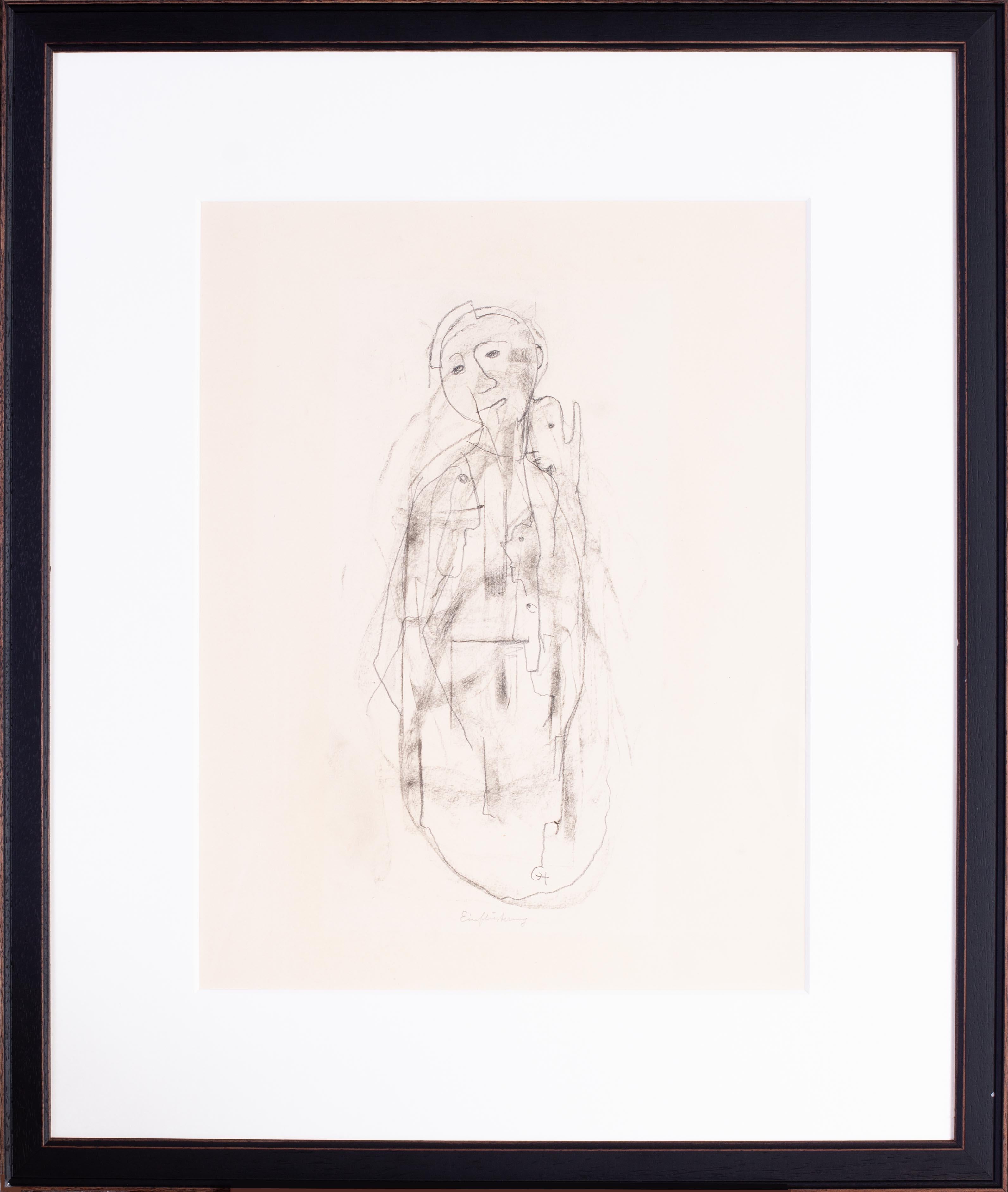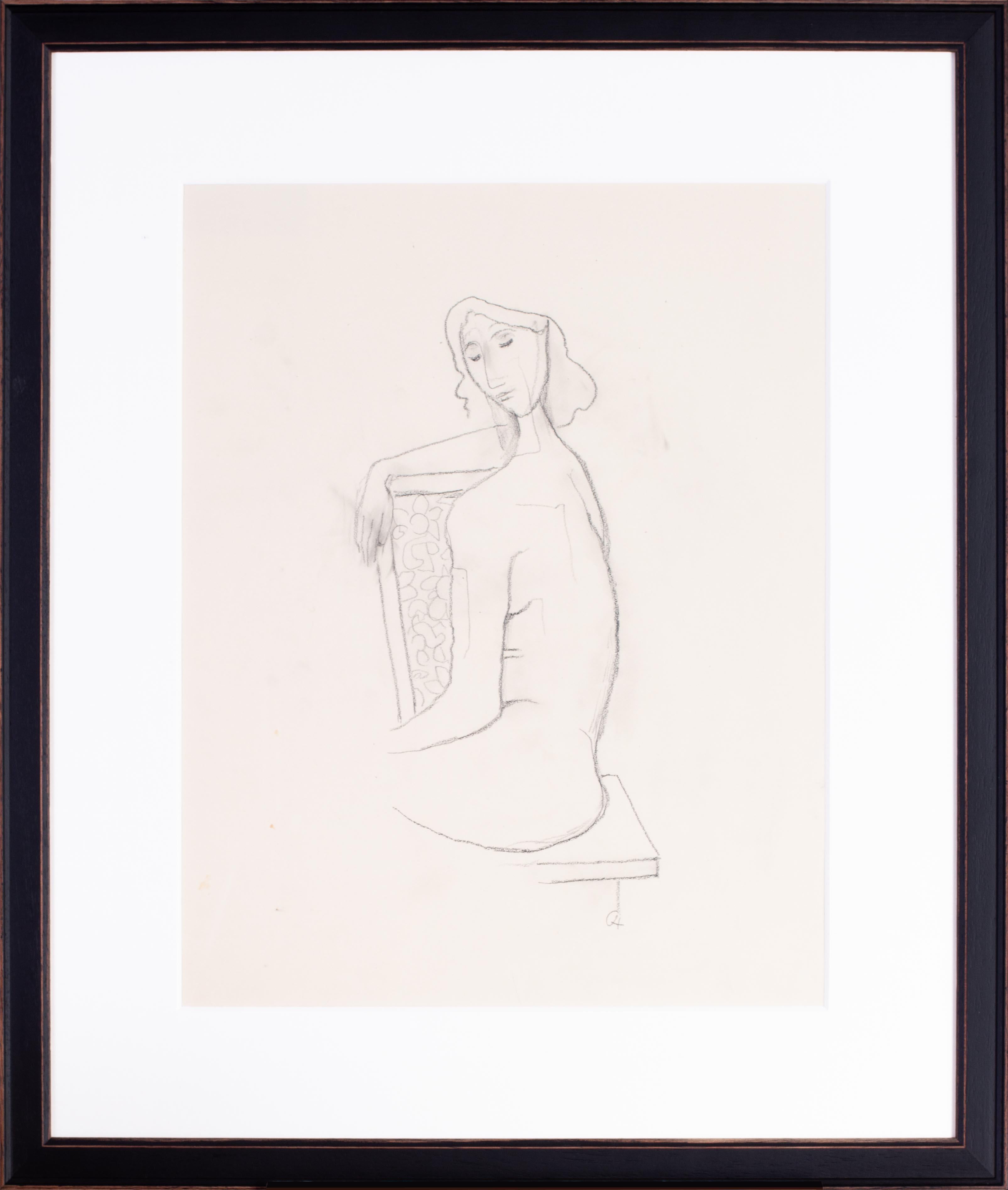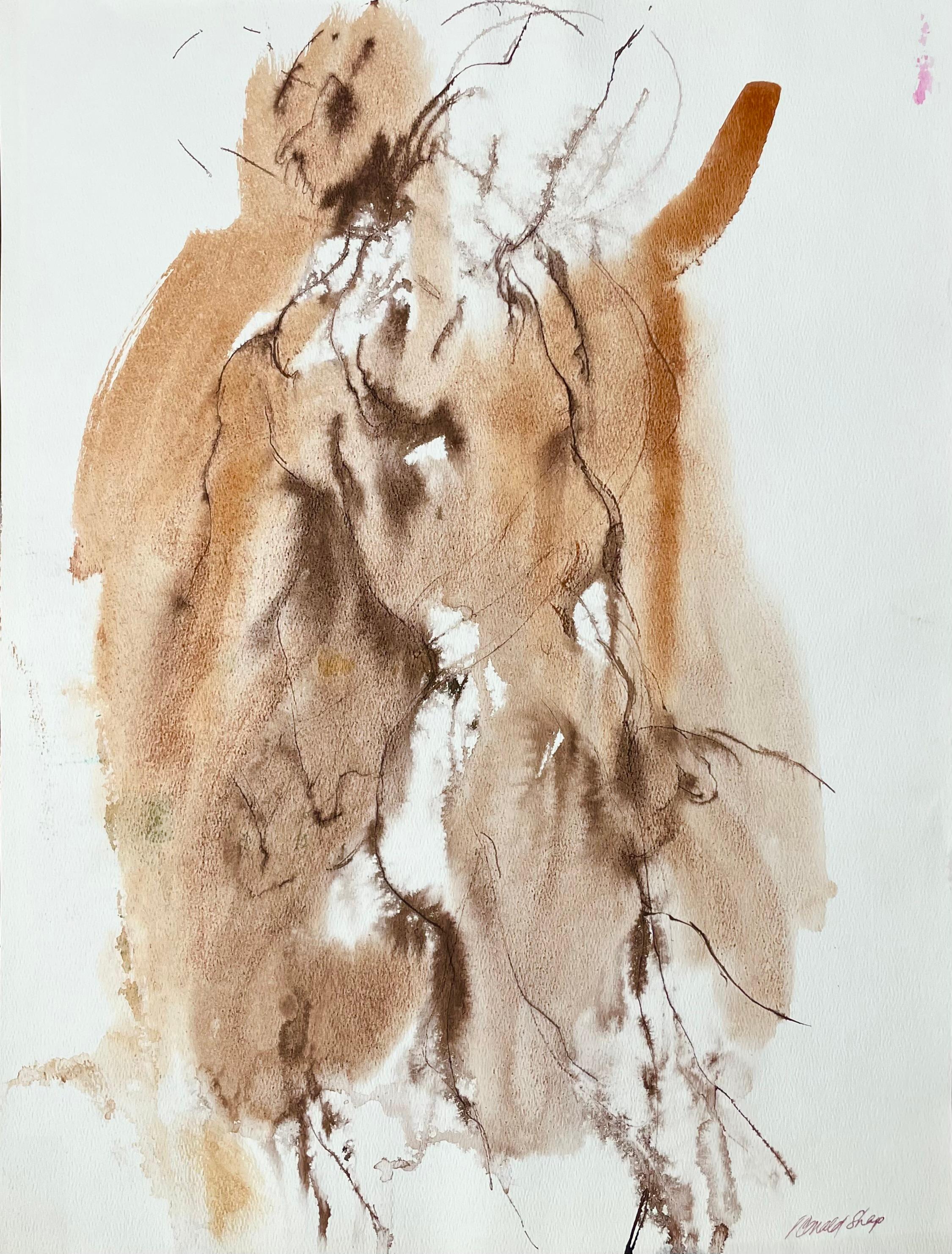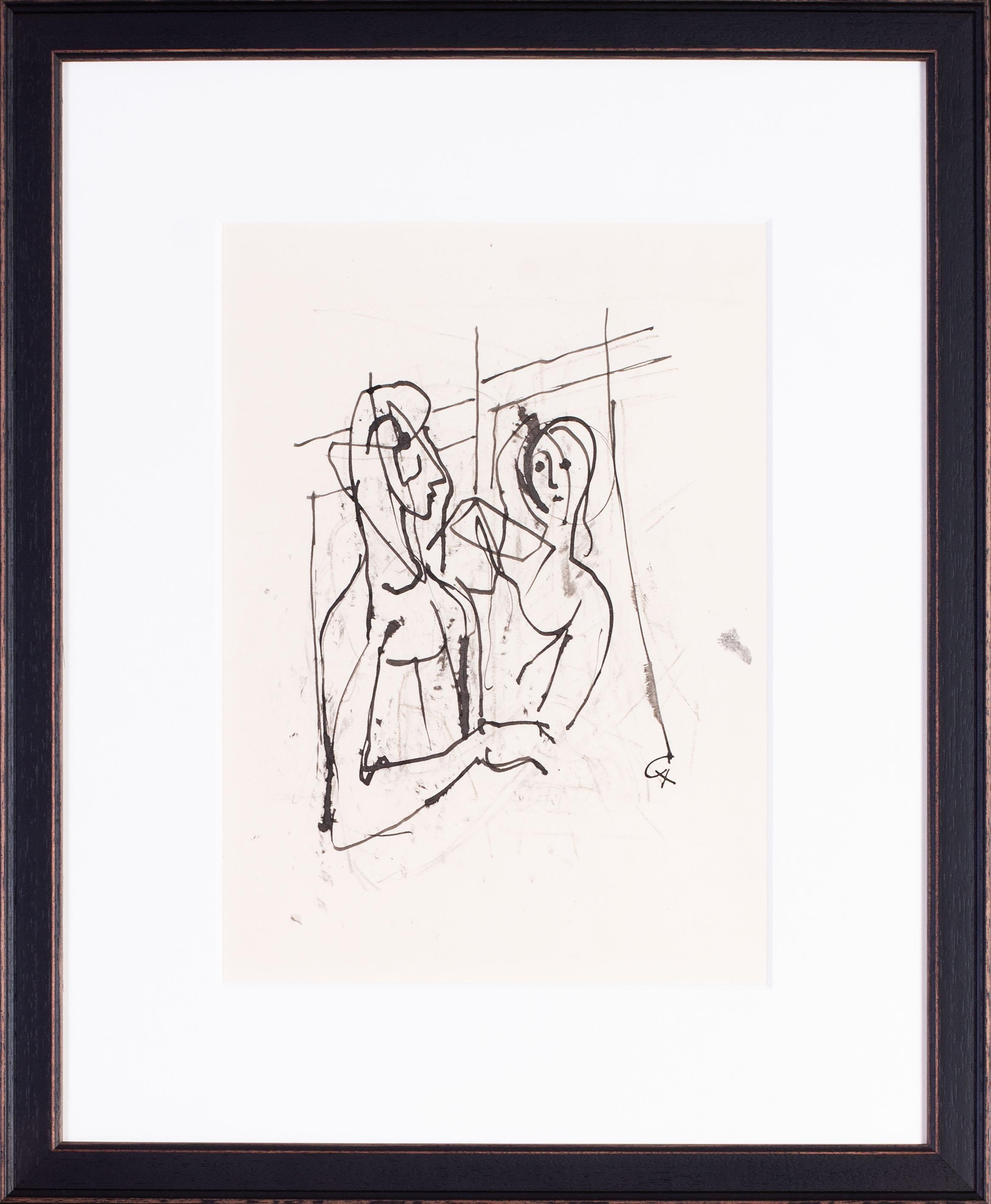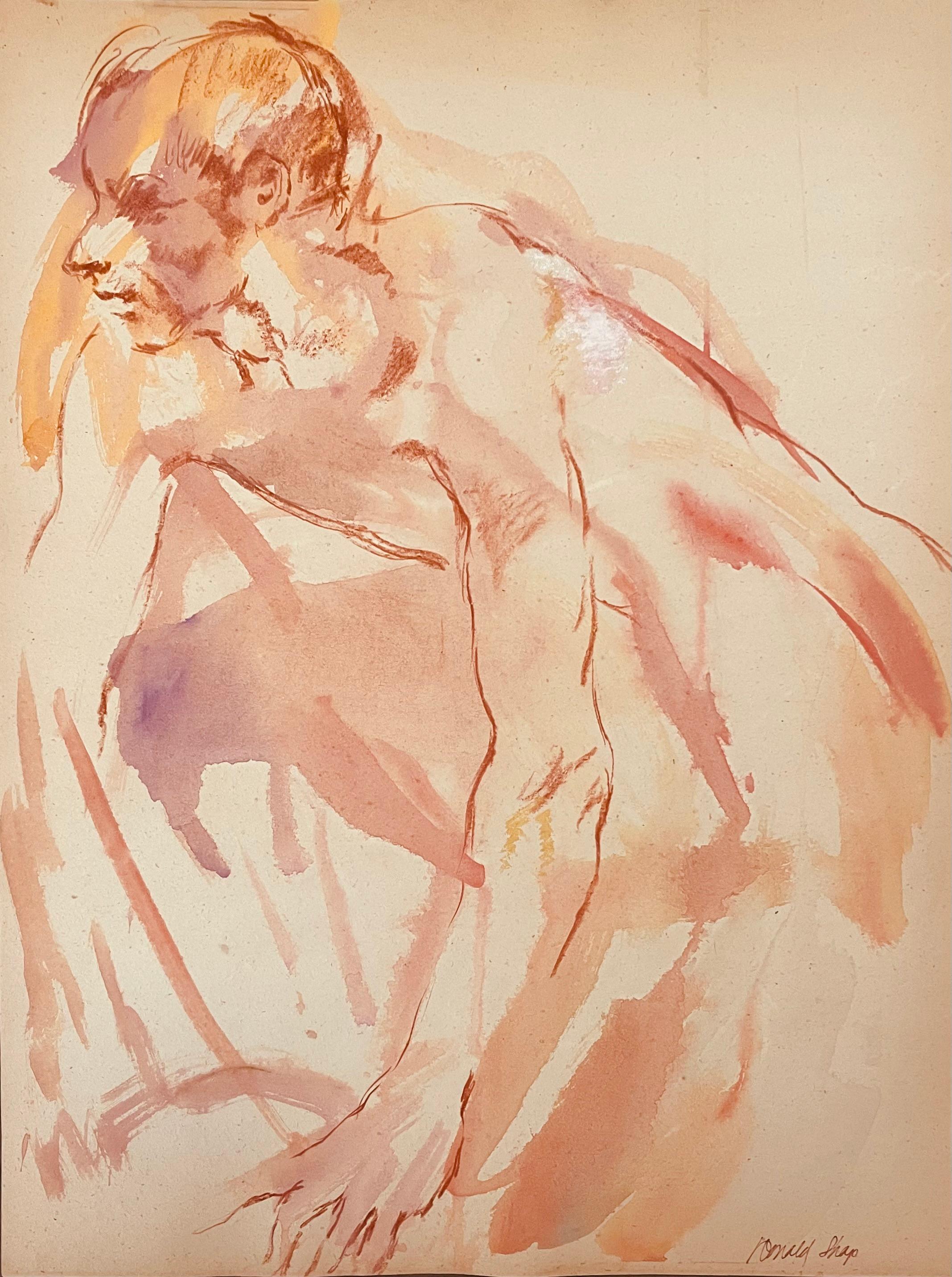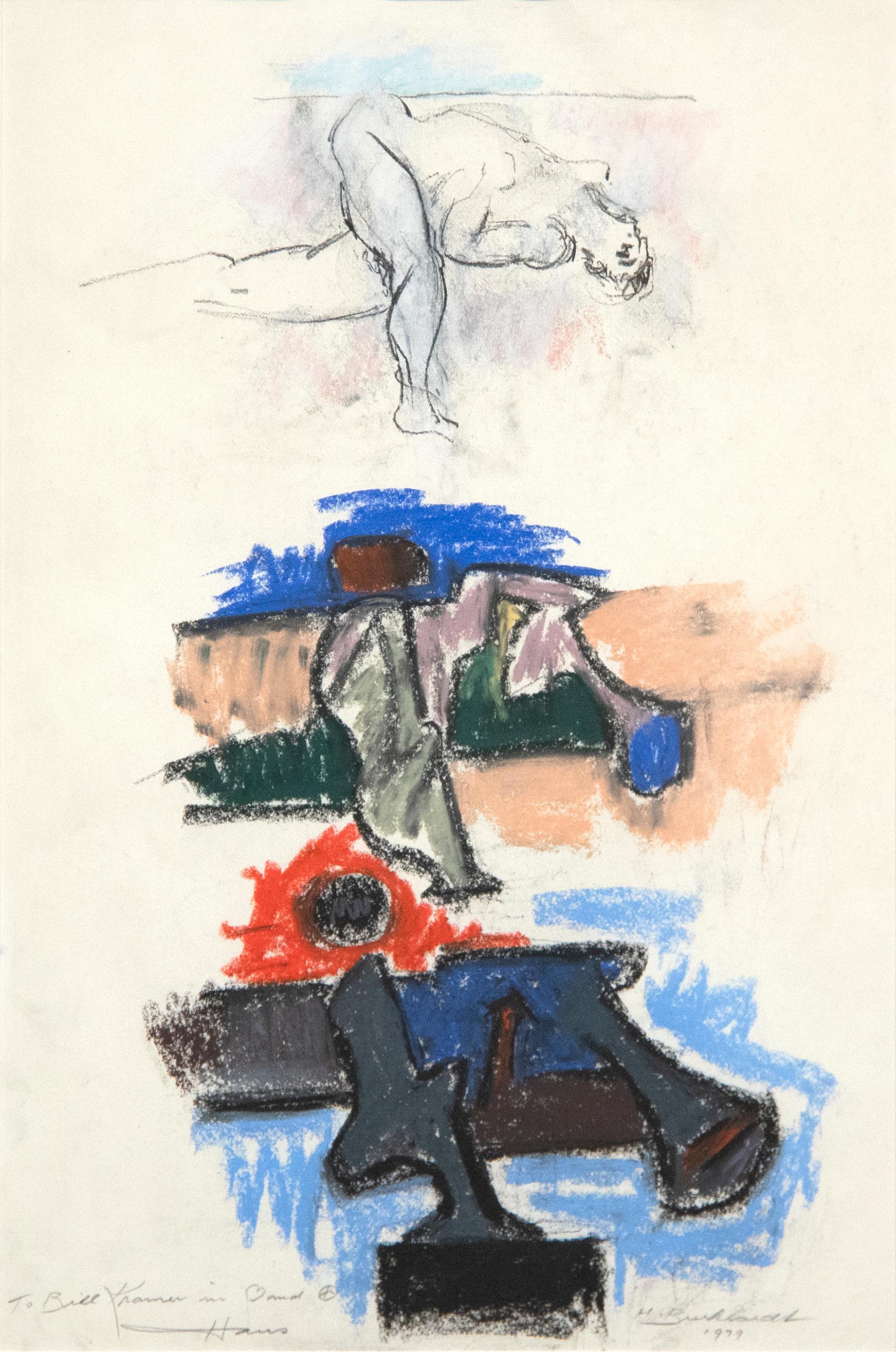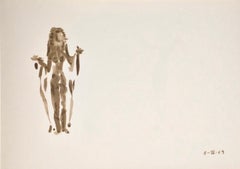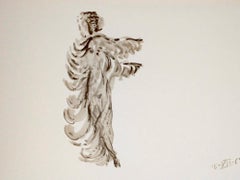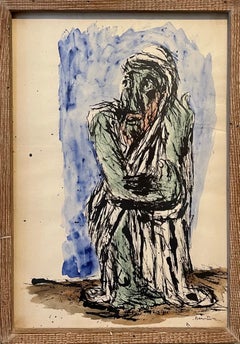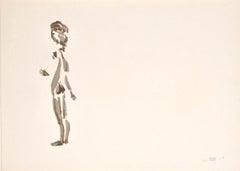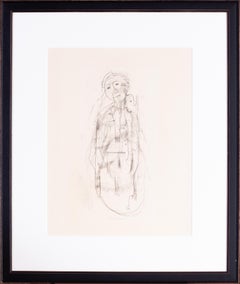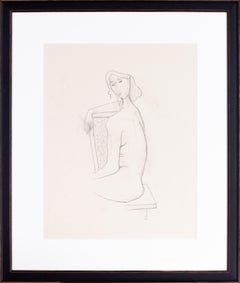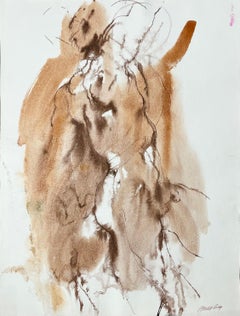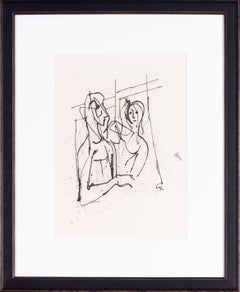Items Similar to Expressionist Figure Study
Want more images or videos?
Request additional images or videos from the seller
1 of 6
Sigmund MenkesExpressionist Figure Study
$1,800
£1,363.84
€1,564.90
CA$2,532.89
A$2,784.34
CHF 1,463.32
MX$33,812.07
NOK 18,254.59
SEK 17,294.94
DKK 11,679.24
About the Item
Genre: Expressionist
Subject: Figures
Medium: Ink
Surface: Paper
Dimensions w/Frame: 14 1/4" x 12 1/4"
Zygmunt (Sigmund) Menkes
born in Lviv (Galicia, Austro-Hungarian Empire) Polish painter of Jewish origin, born in 1896 in Lvov, died in 1986 in Riverdale, New York. Member of the École de Paris group in the 1920s and 1930s. From the beginning of 1935 he lived and worked in the United States; he was a representative of the Expressionist Colorism movement.
Menkes began his artistic studies in 1912 at the Industrial School in Lviv. At the same time he worked as a restorer of rural churches. Between 1919 and 1922 he supplemented his studies at Krakow's Academy of Fine Arts and in 1922 expanded on this education and broadened his artistic skills in the private studio of Alexander Archipenko in Berlin. In 1923 Menkes settled in Paris, where he became a member of the École de Paris - a community that was primarily made up of artists hailing from Central and Eastern Europe who rented inexpensive studios in the "La Ruche" building in the Montparnasse district. Menkes developed close friendships with Eugeniusz Zak and Marc Chagall. Two years later, Menkes made the decision to settle permanently in France. He participated in a series of the city's salons, including the Salon d'Automne (1924, 1925, 1927), the Salon des Independants (1925-1928), and Tuileries Salon (1928, 1929, 1931, 1938). He presented his works in a number of Parisian galleries, among them, the Bernheim, de France, and Le Portique. In 1930 the artist traveled to the United States to present his work in Cleveland and New York. He also exhibited his paintings in Canada and England. He visited Poland frequently, spent time in Berlin in 1928, and toured Spain with Artur Nacht-Samborski in 1935, moving to the United States the same year.
In 1936 Menkes had his first solo exhibition in New York at the Sullivan Gallery on 57th Street. He also worked with the Associated American Artists Gallery and the French Art Gallery, and for years was a lecturer at the Art Students League. Solo exhibitions of his work were organized by the Galerie Le Portique in Paris (1928), the Friends of Fine Arts Society in Lviv (1930), and at the Jewish Society for Support of the Fine Arts in Warsaw (1931). In Poland the artist was a member of groups with a Coloristic orientation, including Nowa Generacja (New Generation) and Zwornik (Keystone), participating in their exhibitions in Lviv (1932, 1935) and Warsaw (1935, 1938). Menkes received a series of important distinctions for his work, including the Carol H. Beck Medal of the Pennsylvania Academy of Fine Arts (Philadelphia, 1943), the Gold Medal of the Corcoran Gallery (Washington, D.C., 1947), the Andrew Carnegie Award of the National Academy of Design (New York, 1955), and the Alfred Jurzykowski Award (New York, 1967).
Menkes's repertoire included figural compositions, portraits, nudes, still lifes, and landscapes. Early in his career his paintings exhibited a Fauvist aesthetic. Menkes's creative stance was especially strongly influenced by the work of Henri Matisse. Women depicted in interiors were a frequent motif; their approximated shapes were surrounded by fluid, bending contour lines that at times broke free of the color areas they surrounded. There was a decorative value in his canvasses, deriving from the inclusion of various fabric and wallpaper designs in the composition. Menkes also frequently painted scenes from the lives of the Jewry, depicting religious rituals and rabbis penetrating the words of the Torah. With time he intensified the expressiveness of his paintings, using only color patches to build forms, placing paint on canvas quickly and spontaneously. The artist's signature, signed with vigor in vermilion red, was also an important element in the structure of his compositions. Menkes's works of the late 1920s and the 1930s are compared with Chaim Soutine's Expressionistic formulas of representation. The artist drew his iconography from the Bible, saturating his religious scenes with nostalgia (Ecce Homo). His landscapes, painted in provincial towns and the mountains of southern France, emanate sensuality and demonstrate the artist's extreme sensitivity for the qualities of color and light. Menkes also created a moving series of World War II paintings depicting Jews enclosed in the Warsaw Ghetto and murdered there by the Nazis. These works were distinct for their washed out dominant blues and grays. In time the artist began to paint increasingly complicated configurations of lines, thickened line configurations, and richly textured planes. His expansive still lifes and interior scenes - often depicting the artist's studio in Riverdale, New York - were composed of balanced, multi-directional configurations of lines. Figures and objects were melded ever more precisely with backgrounds, while his color schemes, dominated by hues of blue, black and white, evoked nostalgia. Lively accents were restricted to small patches of pink and yellow. In his later works, which bordered on abstract allusions, we encounter a radical turn towards geometric forms painted in a range of intense, strong, contrasting colors. In addition to painting oils on canvas, Menkes produced gouaches, watercolors, and drawings. He also created a series of sculptures, primarily during a prolonged visit to Italy with Jacques Lipchitz.
The work of Mr. Menkes, an Expressionist, won many awards and hangs in major art institutions and private collections, including the recently closed Museum of the Jeu de Paume in Paris; the Philadelphia Museum of Art; the Whitney Museum in Manhattan; the Wichita (Kan.) Museum; the Newark Museum; the Corcoran Museum in Washington; the Cranbrook Academy in Detroit; the Jewish Museum in Manhattan; the Betsalel Museum in Jerusalem, and the Tel Aviv Museum.
Among the awards he received were the Clark Prize of the Corcoran Gallery, in 1941; the Carol H. Beck Medal of the Pennsylvania Academy, in Philadelphia, in 1943; the Andrew Carnegie award from the National Academy of Design, in Manhattan, in 1955, and the National Academy award for foreign painters, in 1963.
- Creator:Sigmund Menkes (1896 - 1986, American, Polish)
- Dimensions:Height: 14.25 in (36.2 cm)Width: 12.25 in (31.12 cm)
- Medium:
- Movement & Style:
- Period:
- Condition:frame has some wear.
- Gallery Location:Surfside, FL
- Reference Number:1stDibs: LU38211809392
About the Seller
4.9
Platinum Seller
Premium sellers with a 4.7+ rating and 24-hour response times
Established in 1995
1stDibs seller since 2014
1,810 sales on 1stDibs
Typical response time: 1 hour
- ShippingRetrieving quote...Shipping from: Surfside, FL
- Return Policy
Authenticity Guarantee
In the unlikely event there’s an issue with an item’s authenticity, contact us within 1 year for a full refund. DetailsMoney-Back Guarantee
If your item is not as described, is damaged in transit, or does not arrive, contact us within 7 days for a full refund. Details24-Hour Cancellation
You have a 24-hour grace period in which to reconsider your purchase, with no questions asked.Vetted Professional Sellers
Our world-class sellers must adhere to strict standards for service and quality, maintaining the integrity of our listings.Price-Match Guarantee
If you find that a seller listed the same item for a lower price elsewhere, we’ll match it.Trusted Global Delivery
Our best-in-class carrier network provides specialized shipping options worldwide, including custom delivery.More From This Seller
View AllApeles Fenosa Spanish Sculptor Mourlot Lithograph Abstract Expressionist Figures
By Apelles Fenosa
Located in Surfside, FL
This is from a hand signed, limited edition (edition of 125) folio or full page lithographs some having a poem verso. The individual sheets are not signed or numbered. This listing ...
Category
1970s Expressionist Figurative Prints
Materials
Lithograph
Apeles Fenosa Spanish Sculptor Mourlot Lithograph Abstract Expressionist Figures
By Apelles Fenosa
Located in Surfside, FL
This is from a hand signed, limited edition (edition of 125) folio or full page lithographs some having a poem verso. The individual sheets are not signed or numbered. This listing ...
Category
1970s Expressionist Figurative Prints
Materials
Lithograph
Abstract Expressionist Rabbi Watercolor Painting Jewish American Modernist WPA
By Ben-Zion Weinman
Located in Surfside, FL
Watercolor painting of standing prophet or Rabbi, Judaica artwork
Born in 1897, Ben-Zion Weinman celebrated his European Jewish heritage in his visual works as a sculptor, painter, ...
Category
Mid-20th Century Expressionist Abstract Drawings and Watercolors
Materials
Paper, Watercolor
Apeles Fenosa Spanish Sculptor Mourlot Lithograph Abstract Expressionist Figures
By Apelles Fenosa
Located in Surfside, FL
This is from a hand signed, limited edition (edition of 125) folio or full page lithographs some having a poem verso. The individual sheets are not signed or numbered. This listing ...
Category
1970s Expressionist Figurative Prints
Materials
Lithograph
German Neo Expressionist Color Pencil Drawing Erwin Pfrang
Located in Surfside, FL
Erwin Pfrang, German (b. 1951)
Graphite, Colored Pencil on paper
Framed 20.5/8 X 16.5/8 sheet 6 X 7.75
Erwin Pfrang (born 1951, in Munich) is a German painter and printmaker.
Pfra...
Category
1980s Neo-Expressionist Figurative Drawings and Watercolors
Materials
Paper, Pencil, Color Pencil
Untitled (7) Figural Expressionist Nude Charcoal Drawing
By Steven Harvey
Located in Surfside, FL
Subject: Figures
Medium: Other, Charcoal
Surface: Paper
Country: United States
Dimensions w/Frame: 27 1/4" x 20 1/4"
without frame 15.25" X22.75"
EDUCATION
New York Studio School of Painting , Drawing & Sculpture 1973
Empire State College, B.A., Painting and Curatorial Studies 1999
ONE PERSON EXHIBITIONS
Mirrors, Gallery Schlesinger, New York, N.Y. 1999
Figures, Gallery Schlesinger, New York, N.Y. 1997
Sexual Monochromes, Gallery Schlesinger, New York, N.Y. 1992
"Paintings", 17th Street Gallery, New York, N.Y. 1976
SELECTED GROUP EXHIBITIONS
Family Line- drawings and paintings by Anne Harvey, Jason Harvey
and Steven Harvey, New York Studio School, New York, NY 2002
Steven Harvey- Paintings and Bruce Gagnier - Sculpture,
Gallery Schlesinger, New York, NY 2000
Woman, Gallery Schlesinger, New York, N.Y. 1999
Water and Light, Mary Gearhart Gallery, New York, N.Y. 1997
Contemporary Figures, M B Modern Gallery 1997
On Air, St. PeterÃs Church, N.Y. 1997
People , Places and Things: An Exploration of the Portrait, 1996-97
New York Studio School
Cafe El Maroc, Jamaica Arts Center 1994
Paintings, Schlesinger Gallery 1993
WFMU Benefit Auction, Germans Van Eck Gallery 1992
Night, Trenkmann Gallery 1991
ACT UP Benefit Auction, Paula Cooper Gallery 1990
Figuring Eros, Director's Annual, Snug Harbor
Cultural Center, Staten Island, N.Y. 1990
Erotic America, Galerie Antoine Candeau, Paris, France 1989
Of Another Nature, Loughelton Gallery, N.Y.C. 1988
New Territories in Art: Europe/America, curated by
Achille Bonito Oliva, Francavilla Al Mare, Italy 1987
Spatial FX, Annina Nosei Gallery 1987
Paint/Film, Bess Cutler Gallery 1987
Melancholy, Anne Plumb Gallery 1987
Group Invitational, Schlesinger Gallery 1986
Thought Objects, Cash/Newhouse Gallery 1985
Saloon/Salon, Bill Rice Gallery 1985
Steven Harvey has worked as an art advisor, art dealer, curator, and writer for over 25 years. He is the director of Steven Harvey Fine Art Projects in NYC, a gallery focused on contemporary painting, which he founded in 2007. SHFAP moved to the lower east side in 2011. It exhibits contemporary artists including Susanna Coffey, Kurt Knobelsdorf, Sangram Majumdar, Stuart Shils, Gideon Bok, Eleanor Ray...
Category
Early 2000s Neo-Expressionist Nude Drawings and Watercolors
Materials
Paper, Charcoal
You May Also Like
German expressionist drawing by Carl Hofer' Whispering'
By Carl Hofer
Located in Petworth, West Sussex
Carl Hofer (German, 1875 – 1955)
Einflusterung (Whispering)
Charcoal and pencil on paper
Signed and inscribed ‘Einflusterung’ (lower middle)
17.1/4 x 13.3/8 in. (43.8 x 34 cm.)
Provenance: These works come from the artist’s second wife Elizabeth and from then by descent.
Carl Hofer was a German expressionist painter and the director of the Berlin Academy of Fine Arts. One of the most important painters of the Expressionist movement, his work was among those that was considered degenerate art by the Nazis. He studied in Karlsruhe under Hans Thoma. He first visited Paris in 1899 making acquaintance with Julius Meier-Graefe. In 1902 he studied in Stuttgardt and became friends with the sculptor Hermann Haller...
Category
20th Century Expressionist Figurative Drawings and Watercolors
Materials
Paper, Charcoal
German Expressionist drawing by Carl Hofer of one of his models
By Carl Hofer
Located in Petworth, West Sussex
Carl Hofer (German, 1875 – 1955)
Das Modell (The artist’s model)
Black crayon on paper
Signed with monogram ‘CH’ (lower right)
18 x 14.1/8 in. (45.8 x 36 cm.)
Provenance: These works come from the artist’s second wife Elizabeth and from then by descent.
Carl Hofer was a German expressionist painter and the director of the Berlin Academy of Fine Arts. One of the most important painters of the Expressionist movement, his work was among those that was considered degenerate art by the Nazis. He studied in Karlsruhe under Hans Thoma. He first visited Paris in 1899 making acquaintance with Julius Meier-Graefe. In 1902 he studied in Stuttgardt and became friends with the sculptor Hermann Haller...
Category
20th Century Expressionist Figurative Drawings and Watercolors
Materials
Paper, Crayon
Original Ronald Shap figure drawing, signed
Located in Columbus, OH
Original gouache and ink nude figure drawing by celebrated, twentieth-century California impressionist landscape painter, Ronald Shap. Torso and buttocks of man with arm raised in wa...
Category
1980s Contemporary Nude Drawings and Watercolors
Materials
Ink, Gouache
German Expressionist drawing by Carl Hofer of lovers
By Carl Hofer
Located in Petworth, West Sussex
Carl Hofer (German, 1875 – 1955)
Die Liebenden (The lovers)
Black ink and remnants of crayon on paper
Signed with monogram ‘CH’ (lower right)
13.3/4 x 9.3/4 in. (35 x 24.8 cm.)
P...
Category
20th Century Expressionist Figurative Drawings and Watercolors
Materials
Paper, Crayon, Ink
Original Ronald Shap figure drawing, signed
Located in Columbus, OH
Original oil pastel and gouache figure drawing by celebrated, twentieth-century California landscape painter, Ronald Shap. Sketch of nude man crouching. Be...
Category
1980s Contemporary Nude Drawings and Watercolors
Materials
Oil Pastel, Gouache
Untitled (Abstract Figure Study)
By Hans Burkhardt
Located in Palm Desert, CA
"Untitled (Abstract Figure Study)" is an abstract figurative Post War mixed media on paper painting by Hans Burkhardt in 1979. The artwork is 22 1/2 x 15 inches and, with the frame, ...
Category
20th Century Post-War Figurative Paintings
Materials
Paper, Mixed Media
More Ways To Browse
Figure Drawings
Expressionist Painting Pink And Blue
Expressionist Figure
Midcentury European Street Scene Painting
Jeu De Paume
Mid Century Drawings Figure
Jew Painting
Andrew Carnegie
W Clark Mid Century Painting
Zygmunt Menkes
Marc Chagall Signed Rabbi Torah
Figure Drawings
Framed Watercolor Landscape
American Watercolours
Vintage Pastel Art
19th Century Watercolour
Watercolor Paintings Of A Flower
Nude Watercolour Paintings
